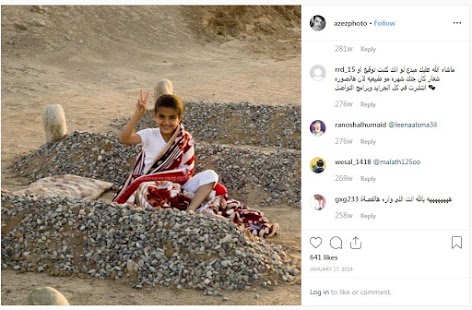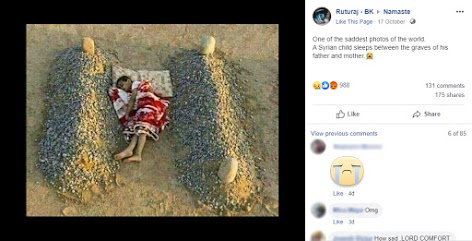The Statement
AAP FactCheck examined a Facebook post from October 17, 2019 by Rutaraj – BK which shows a boy sleeping on the ground on a pillow with a red and white blanket between two rock mounds.
The post’s caption states, “One of the saddest photos of the world. A Syrian child sleeps between the graves of his father and mother” and features a crying emoji.
Rutaraj – BK’s page has more than 1900 likes and describes itself as a personal blog on Facebook.
The post has been shared more than 170 times and attracted more than 130 comments and 980 reactions. A similar version was posted by Sydney-based freelance video production unit, Nahda Productions, which included a heading, “A Syrian boy sleeping between the graves of his parents (killed by Assad forces)”.
The Analysis
The photo in the Facebook post was originally taken by Saudi photographer Abdul Aziz Al-Otaibi who posted a black an white version to his Instagram page on January 4, 2014. The post’s translated caption reads, “Lying between the living quarters housing between his mother and father #Pictorial I hope the idea you like everyone writes a phrase for Halsoura and tells the story who understood from the picture.”
Al-Otaibi posted a colour version of the photo on January 8, 2014 on his Instagram page with the caption which reads, “some kids might feel that their dead parents’ bodies are more affectionate to them than the people they’re living with.”
On January 17, 2014, Al-Otaibi posted a screenshot of a tweet by Twitter user @americanbadu which showed his image of the boy sleeping in between two piles of rocks. In Al-Otaibi’s tweet caption, according to Google Translate, he wrote, “A picture from my photo he steals it and attributes it to a child from Damascus whose parents were killed and what do people feel when you lie” with two angry face emojis.

Harald Doornbos, a Dutch journalist based in the Middle East, identified @americanbadu as an “American convert” who lived in Saudi Arabia and had 187,000 Twitter followers. He wrote in a blog post @americanbadu published the image to his Twitter account claiming “the picture is from Syria and suggests the dead parents of the boy were killed by the Assad-regime”.
According to Doornbos, within minutes hundreds of accounts had retweet @americanbadu’s post and that “Western tweeps also began noticing the dramatic picture. They too put it on Twitter and Facebook”. He also claimed to be the first reporter who called Al-Otaibi to ask if the picture was taken in Syria.
In a subsequent tweet, Al-Otaibi posted a collage of four photos showing the child around the piles of rock. In the tweet, he labelled the images “backstage” photos and said the child was his nephew.
Al-Otaibi tweeted another photo of his nephew sitting and smiling in between the piles of rocks with the translated caption reading, “This is after a behind-the-scenes picture of Brahim, my brother’s son.” Al-Otaibi posted the same image with a similar caption to his Instagram page.
Al-Otaibi told Doornbos the photos were part of a photography project he was working on and that he had driven “to the outskirts of Yanbu, 250 kilometers away from Jeddah” where he constructed the two graves from rocks and asked his nephew to lay down between the graves.
“Every artist has ideas in his head. So I had the idea to make a project whereby I show in pictures how the love of a child for his parents is irreplaceable. This love cannot be substituted by anything or anybody else, even if the parents are dead,” he explained.
Al-Otaibi told Doornbos he sent @americanbadu a direct message on Twitter asking, “Why did you take my picture and claim it is an image from Syria? Please correct it.” He said @americanbadu responded with, “Why don’t you just let go and claim it is a picture from Syria and gain a reward from God. You are exaggerating.” Shortly after the exchange @americanbadu removed the tweet.
Al-Otaibi said he was “very annoyed” and it was “not fair to take one of my photos totally out of context and use it for your own propaganda.”
The Saudi photographer also posted screenshots of media reports debunking the false captions on his Instagram and Twitter accounts, writing, “Praise be to Allah, the media in the world understood a lot about the reality of the picture and reaped contacts and emails of many media people make sure and inquire about the picture and convey the truth in all realism has become a war and tossing and cursing and insulting and questioning the intentions and people claim in networking networks and some supporter and encouraging responses were very positive”.
The Verdict
Based on the evidence, AAP FactCheck found the Facebook post to be false. The image by Saudi photographer Abdul Aziz Al-Otaibi features his nephew laying in between two piles of rocks and was created to look like graves as part of a photo art project. The picture was taken out of context and miscaptioned to claim the image was in Syria rather than Yanbu, Saudi Arabia and implied that his parents had died.
False – The primary claim of the content is factually inaccurate.
* AAP FactCheck is an accredited member of the International Fact-Checking Network. To keep up with our latest fact checks, follow us on Facebook, Twitter and Instagram.
First published October 22, 2019, 17:29 AEST


















